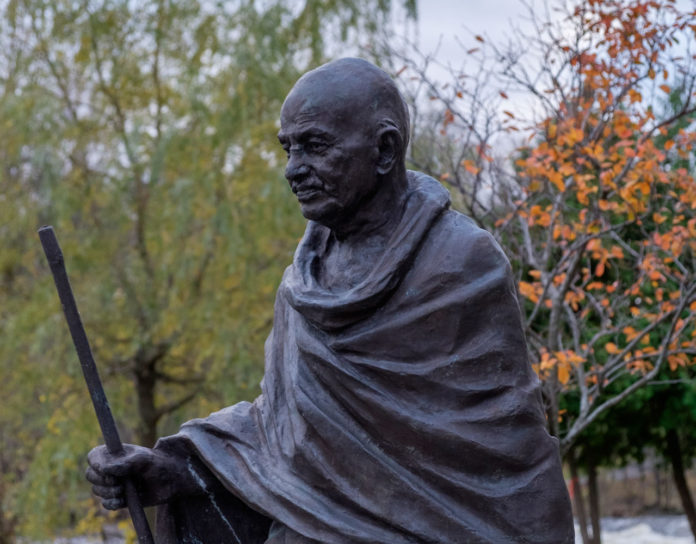
Standing firmly between Richcraft Hall (formerly the River Building) and Steacie Building is a statue of Mohandas Karamchand Gandhi.
More popularly known as “Gandhi,” he is known around the world as the anti-colonial leader who (supposedly) brought an end to the British colonization of India single-handedly. In the West, many argue he is one of the greatest individuals to ever tread this earth-that he is the activist who guided India to its independence through the application of his now well-known philosophy of non-violence.
Yet, it is insufficient to state the obvious about Gandhi without questioning the legacy of the man we have collectively placed on a moral pedestal. Gandhi was a racist. He utilised anti-Black racism as a weapon to bargain with the British about the subjugation of Indians living in South Africa. Instead of a pacifist liberator, he actually furthered the entrenchment of the caste system in India as well.
In 1893, Gandhi’s political activism in South Africa began with the advocacy of anti-Black racism, the notion that Black Africans are not human. In their 2015 book The South African Gandhi, authors Ashwin Desai and Goolam Vahed assert that Gandhi had an inherent “disdain for Black Africans.” He was known to explicitly refer to Black South Africans as “Kaffir,” a derogatory term on the same level as the N-word. In his 20 years in South Africa, Gandhi’s racism towards Black peoples was made clear.
His first encounter at a Durban post office was not about the racially segregating policy of the apartheid South African government, but regarding his disagreement on why “Indians should be classed with the natives.” In illustrating his point, he advocated for further segregation between people of colour, demanding separate entrance to the Durban office for Indians. Likewise, during an 1896 speech in Bombay, Gandhi portrayed Africans as savages:
“Ours is one continual struggle against a degradation sought to be inflicted upon us by the Europeans, who desire to degrade us to the level of the raw Kaffir whose occupation is hunting, and whose sole ambition is to collect a certain number of cattle to buy a wife with and, then, pass his life in indolence and nakedness.”
Gandhi’s portrayal of “savage” Africans was a tired attempt to garner European validation, one used to dismiss the rights of Black Africans throughout history. He believed that “whites and Indians were bonded by an Aryan bloodline that had no place for the African.” This was why he advocated for a predominantly white race in South Africa. This was why he often referred to Black Africans as Kaffirs, as uncivilized, and as savages. Gandhi’s anti-Black racism equaled his support of an entrenched caste system, one others vehemently campaigned against, like the anti-caste activist B.R. Ambedkar in his still radical text, Annihilation of the Caste.
Moreover, Gandhi’s sordid ideas extended to his beliefs about women. In addition to being an anti-Black racist, he was also a sexual predator and misogynist who viewed women’s sexuality with contempt and disgust.
In placing him on a moral pedestal, this is the absent history of Gandhi: a violent man who slept with underage girls—including his niece—to “test” his own sexual imperturbability. During his time in South Africa, Gandhi actually responded to the rape of one of his women followers by cutting her hair, further encouraging the myth that heterosexual rape is caused by women’s appearances and blame should solely be placed on the woman alone.
There are two reasons to reject the myth about Gandhi and the statue placed in his honor. First, the violence of Gandhi’s anti-Black racism has largely been ignored and its history erased because of the overarching positive narrative commonly associated with his activism. Such narratives fail to provide nuance to the impact he had on the various communities he encountered and addressed through his activism. Secondly, they do not account for how his pernicious anti-Blackness still resonates within South Asian communities to the detriment of Black peoples existing within their milieu. To be treated as subhuman is the unacknowledged plight of Black immigrants in India, and of politically disenfranchised Afro-Indians, such as the “siddis.”
The removal of the Gandhi statue poses moral questions as to how we should reimagine our society. For one—how do we commemorate the socially marginalized, whose histories have been largely effaced through the mystification of rather violent, albeit nuanced historical figures?
The removal of the statue is one way of correcting that history and re-thinking the narratives we tell—especially in an institution responsible for creating critical thinkers. Gandhi was a violent man. His proximity to whiteness as one who continually espoused anti-Black rhetoric is, perhaps, one of the reasons behind his apotheosis.
Remove the Gandhi statue.
Photo by Matt Czapalay





